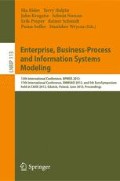Abstract
Many previous attempts at classifying business rules rely on over-simplistic frameworks that conflate business concerns with technical features. Such frameworks hamper traceability between information systems and business needs and can lead to paradoxes that are difficult to reconcile. This paper offers an alternative framework for business constraints, including those that can be embodied in information systems. We assume that such information systems are likely to be automated, but the proposed scheme does not rely on any automation. The paper uses several examples to illustrate the issues that arise with current classification frameworks and the benefits that a more realistic framework can provide.
Access this chapter
Tax calculation will be finalised at checkout
Purchases are for personal use only
Preview
Unable to display preview. Download preview PDF.
References
Carver, A., Morgan, T.: Characterizing Business Rules for Practical Information Systems. In: Halpin, T., Nurcan, S., Krogstie, J., Soffer, P., Proper, E., Schmidt, R., Bider, I. (eds.) BPMDS 2011 and EMMSAD 2011. LNBIP, vol. 81, pp. 443–452. Springer, Heidelberg (2011)
US Senate: Public Company Accounting Reform and Investor Protection Act, Pub.L. 107-204, 116 Stat. 745, enacted July 30 (2002)
The Object Management Group (OMG): OMG Model Driven Architecture, http://www.omg.org/mda/
Halpin, T., Morgan, T.: Information Modeling and Relational Databases, 2nd edn. Morgan Kaufmann (2008)
Zachman International: A Concise Definition of The Zachman Framework (2008), http://www.zachman.com/about-the-zachman-framework
International Standards Organization (ISO): Information technology - Open Distributed Processing - Reference model (RM-ODP), ISO/IEC 10746 (1998)
National Association of State Chief Information Officers (NASCIO): Enterprise Architecture Development Tool-Kit v3.0 (2004), http://www.nascio.org/resources/EAresources.cfm2004
The Object Management Group (OMG): The Unified Modeling Language (UML) Version 2.4.1, http://www.omg.org/spec/UML/2.4.1/
International Standards Organization (ISO): Systems and software engineering - Architecture description, ISO/IEC/IEEE 42010 (2000)
The Open Group: The Open Group Architecture Framework, TOGAF (2011), http://www.opengroup.org/togaf/
The US Department of Defense: DoD Architecture Framework Version 1.5, Volume I: Definitions and Guidelines (DoDAF) (2007), http://dodcio.defense.gov/docs/DoDAF_Volume_I.pdf
The UK Ministry of Defence: MOD Architecture Framework (MODAF) V1.2.004 (2010), http://www.mod.uk/DefenceInternet/AboutDefence/WhatWeDo/InformationManagement/MODAF/
The Object Management Group (OMG): The Business Motivation Model (BMM), Version 1.1 (2010), http://www.omg.org/spec/BMM/1.1/
The Object Management Group (OMG): Semantics Of Business Vocabulary And Rules (SBVR) Version 1.0 (2008), http://www.omg.org/spec/SBVR/1.0/
International Standards Organization (ISO): Concepts and Terminology for the Conceptual Schema and the Information Base, ISO TC97/SC5/WG3 (1982)
Merriam-Webster Dictionary, http://www.merriam-webster.com/
Author information
Authors and Affiliations
Editor information
Editors and Affiliations
Rights and permissions
Copyright information
© 2012 Springer-Verlag Berlin Heidelberg
About this paper
Cite this paper
Carver, A., Morgan, T. (2012). A Framework for Relating Business Constraints to Information Systems. In: Bider, I., et al. Enterprise, Business-Process and Information Systems Modeling. BPMDS EMMSAD 2012 2012. Lecture Notes in Business Information Processing, vol 113. Springer, Berlin, Heidelberg. https://doi.org/10.1007/978-3-642-31072-0_21
Download citation
DOI: https://doi.org/10.1007/978-3-642-31072-0_21
Publisher Name: Springer, Berlin, Heidelberg
Print ISBN: 978-3-642-31071-3
Online ISBN: 978-3-642-31072-0
eBook Packages: Computer ScienceComputer Science (R0)

